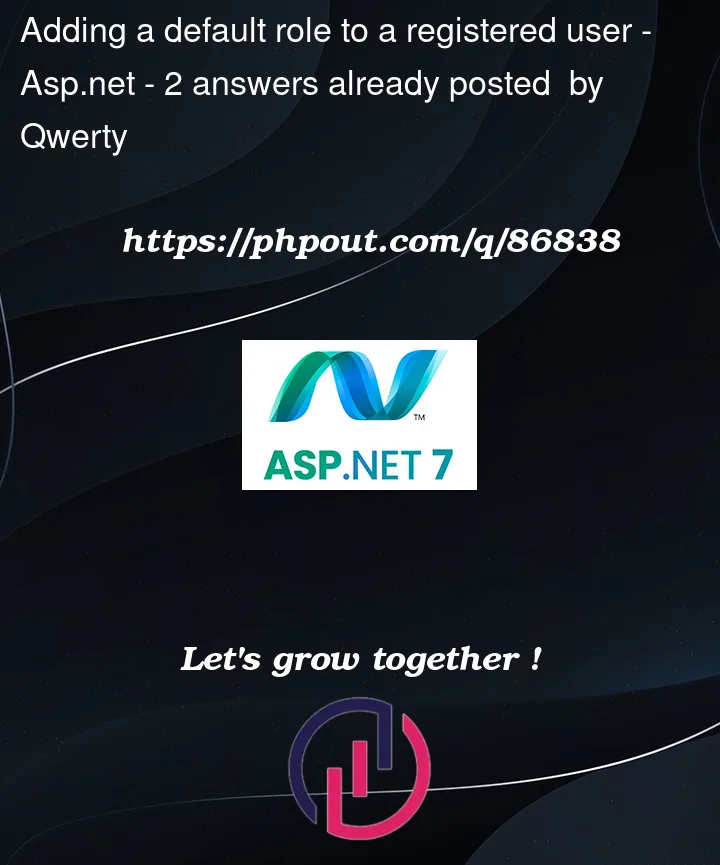There’s three roles and I want to add a default "user" role whenever there’s a registration. I’m using asp.net 6 mvc with identity
What I did it’s not working. I checked the tables and the Identity.AspNetUsers table is updated, the Identity.Roles table is updated but the Identity.UserRoles is not getting updated
Here’s the change I made in Register
public class RegisterModel : PageModel
{
private readonly SignInManager<ApplicationUser> _signInManager;
private readonly UserManager<ApplicationUser> _userManager;
private readonly IUserStore<ApplicationUser> _userStore;
private readonly IUserEmailStore<ApplicationUser> _emailStore;
private readonly ILogger<RegisterModel> _logger;
private readonly IEmailSender _emailSender;
private readonly RoleManager<IdentityRole> _roleManager;
public RegisterModel(
UserManager<ApplicationUser> userManager,
IUserStore<ApplicationUser> userStore,
SignInManager<ApplicationUser> signInManager,
ILogger<RegisterModel> logger,
IEmailSender emailSender,
//Added this
RoleManager<IdentityRole> roleManager)
{
_userManager = userManager;
_userStore = userStore;
_emailStore = GetEmailStore();
_signInManager = signInManager;
_logger = logger;
_emailSender = emailSender;
//Added this
_roleManager = roleManager;
}
[BindProperty]
public InputModel Input { get; set; }
public string ReturnUrl { get; set; }
public IList<AuthenticationScheme> ExternalLogins { get; set; }
public class InputModel
{
[Required]
[EmailAddress]
[Display(Name = "Email")]
public string Email { get; set; }
[Required]
[StringLength(100, ErrorMessage = "The {0} must be at least {2} and at max {1} characters long.", MinimumLength = 6)]
[DataType(DataType.Password)]
[Display(Name = "Password")]
public string Password { get; set; }
[DataType(DataType.Password)]
[Display(Name = "Confirm password")]
[Compare("Password", ErrorMessage = "The password and confirmation password do not match.")]
public string ConfirmPassword { get; set; }
}
public async Task OnGetAsync(string returnUrl = null)
{
ReturnUrl = returnUrl;
ExternalLogins = (await _signInManager.GetExternalAuthenticationSchemesAsync()).ToList();
}
public async Task<IActionResult> OnPostAsync(string returnUrl = null)
{
returnUrl ??= Url.Content("~/");
ExternalLogins = (await _signInManager.GetExternalAuthenticationSchemesAsync()).ToList();
if (ModelState.IsValid)
{
var user = CreateUser();
await _userStore.SetUserNameAsync(user, Input.Email, CancellationToken.None);
await _emailStore.SetEmailAsync(user, Input.Email, CancellationToken.None);
var result = await _userManager.CreateAsync(user, Input.Password);
if (result.Succeeded)
{
_logger.LogInformation("User created a new account with password.");
//Added this
var defaultrole = _roleManager.FindByNameAsync("User").Result;
//Added this
if (defaultrole != null)
{
IdentityResult roleresult = await _userManager.AddToRoleAsync(user, "User");
}
var userId = await _userManager.GetUserIdAsync(user);
var code = await _userManager.GenerateEmailConfirmationTokenAsync(user);
code = WebEncoders.Base64UrlEncode(Encoding.UTF8.GetBytes(code));
var callbackUrl = Url.Page(
"/Account/ConfirmEmail",
pageHandler: null,
values: new { area = "Identity", userId = userId, code = code, returnUrl = returnUrl },
protocol: Request.Scheme);
await _emailSender.SendEmailAsync(Input.Email, "Confirm your email",
$"Please confirm your account by <a href='{HtmlEncoder.Default.Encode(callbackUrl)}'>clicking here</a>.");
if (_userManager.Options.SignIn.RequireConfirmedAccount)
{
return RedirectToPage("RegisterConfirmation", new { email = Input.Email, returnUrl = returnUrl });
}
else
{
await _signInManager.SignInAsync(user, isPersistent: false);
return LocalRedirect(returnUrl);
}
}
foreach (var error in result.Errors)
{
ModelState.AddModelError(string.Empty, error.Description);
}
}
// If we got this far, something failed, redisplay form
return Page();
}
private ApplicationUser CreateUser()
{
try
{
return Activator.CreateInstance<ApplicationUser>();
}
catch
{
throw new InvalidOperationException($"Can't create an instance of '{nameof(ApplicationUser)}'. " +
$"Ensure that '{nameof(ApplicationUser)}' is not an abstract class and has a parameterless constructor, or alternatively " +
$"override the register page in /Areas/Identity/Pages/Account/Register.cshtml");
}
}
private IUserEmailStore<ApplicationUser> GetEmailStore()
{
if (!_userManager.SupportsUserEmail)
{
throw new NotSupportedException("The default UI requires a user store with email support.");
}
return (IUserEmailStore<ApplicationUser>)_userStore;
}
}
}
I tried to follow a tutorial that at some point says "Create an Enum for the supported Roles. Add a new Enum at Enums/Roles" and I have no idea where to put this. Is this supposed to be a new class? I then changed to another tutorial and I didn’t use this but I would like to know anyway
public enum Roles
{
Admin,
User
}




2
Answers
I normally don’t use enums, instead, I use a class like this, which normally works for me:
I have never monitored my database to see how the data is stored, but based on your implementation, it looks like it should work, i.e something like
I don’t know, what do you mean by "Identity.UserRoles is not getting updated"? Have you also tried writing something like this to see the results you get?